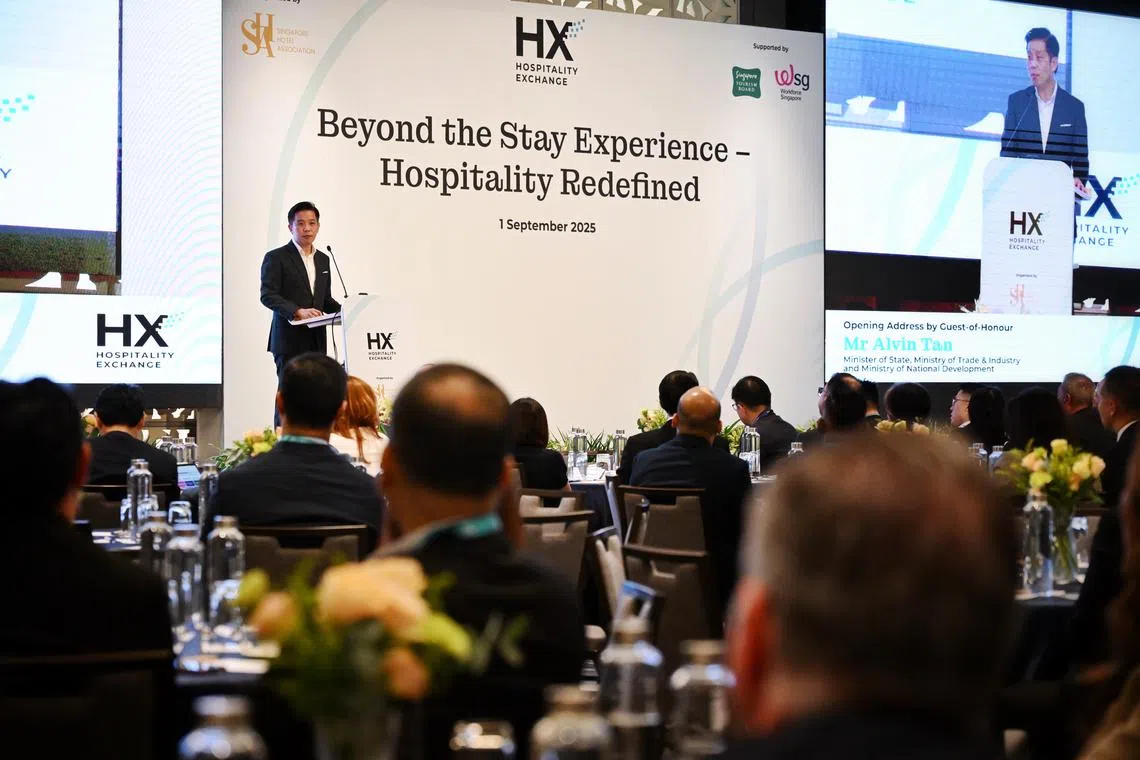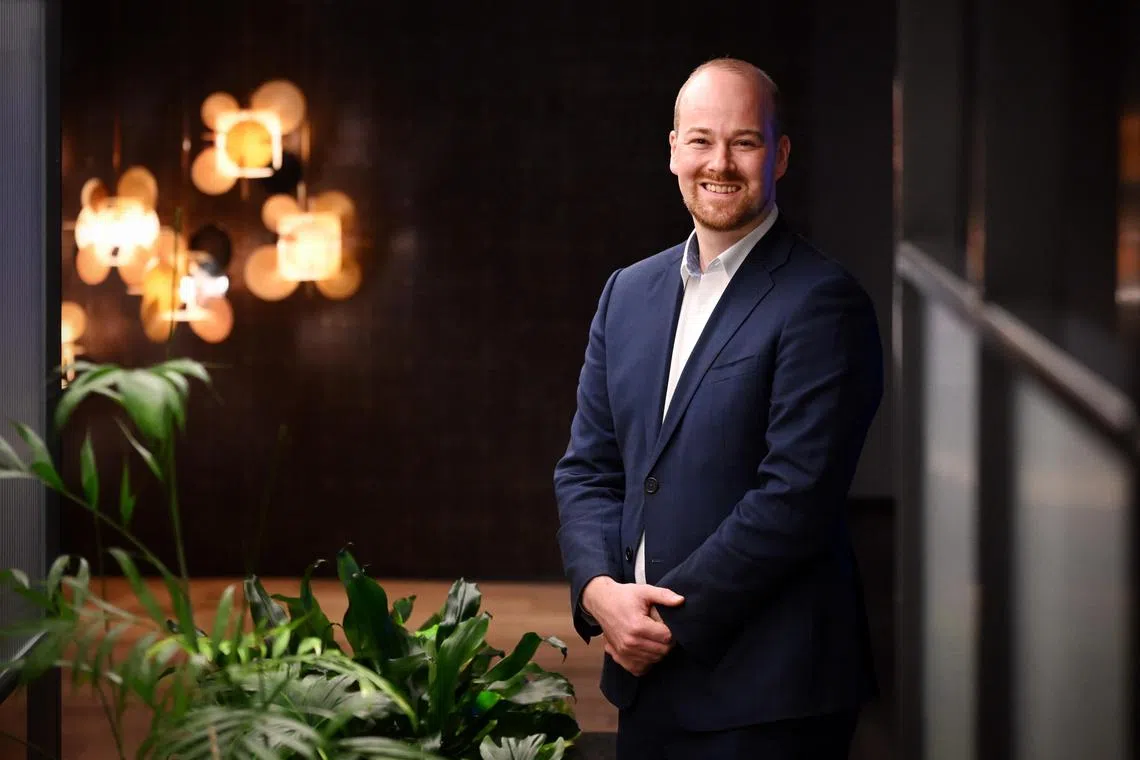Hotel industry digital plan refreshed to keep sector competitive
Sign up now: Get ST's newsletters delivered to your inbox

Minister of State for Trade and Industry and National Development Alvin Tan announcing the refreshed Hotel Industry Digital Plan on Sept 1.
ST PHOTO: KUA CHEE SIONG
Follow topic:
- The updated IDP aims to accelerate the adoption of five key technologies, namely smart rooms, robotics, digital concierge, digital check-in and check-out, and asset management systems.
- SHA and Workforce Singapore will launch a Career Health Workshop in 2025 to retain and develop hotel talent.
- 61 per cent of hotel room stock have achieved internationally-recognised hotel sustainability certificates in 2025 so far.
AI generated
SINGAPORE – Shifts in technology, human capital and sustainability are areas the hotel industry will have to navigate as the sector evolves, and as Singapore pursues its Tourism 2040 goals of quality tourism and higher tourism receipts.
To support this evolution, the authorities announced a refresh of the Hotel Industry Digital Plan (IDP) on Sept 1, designed to keep the sector competitive.
“STB (Singapore Tourism Board) projects that tourism receipts could reach between $47 billion and $50 billion by 2040
“But while Singapore is at this juncture well positioned for growth, we must continue to strengthen our competitive edge as a world-class tourism hub.”
The updated IDP aims to accelerate the adoption of five key technologies, namely smart rooms, robotics, digital concierge, digital check-in and check-out, and asset management systems.
Developed jointly by the STB and the Infocomm Media Development Authority (IMDA) with support from the Singapore Hotel Association (SHA), the IDP builds on the foundation of the original plan introduced in 2019.
“This refreshed IDP maps detailed business journeys across operational touch points and key hotel functions with clearer pathways for hotels to digitalise operations,” said Mr Tan.
“It also includes examples of AI-enabled solutions and how these can enhance guest experience, improve operational efficiency and also accelerate business growth.”
All hotels can now access the refreshed IDP on IMDA’s Chief Technology Officer-as-a-Service platform. This resource has a catalogue of more than 300 pre-approved essential business solutions and relevant training courses to support enterprises on their digitalisation journey. It also includes cyber-security resources to help safeguard businesses.
Mr Tan said hotels can integrate these digital solutions into their property refresh initiatives with grant support from STB’s Business Improvement Fund and the Hotel Rejuvenation Fund, which supports hotels’ renovation and refurbishment efforts.
On the manpower front, Mr Tan spoke of retaining and developing talent. “We are welcoming a new generation of talent... so we must offer more dynamic careers and better support for our people.”
He said SHA and Workforce Singapore were collaborating to hold the first Career Health Workshop for the hotel industry.
To be launched later in 2025, it will train human resources professionals, line managers, and supervisors in essential skills to conduct meaningful career conversations with and implement structured career planning for their employees.
It will also help employers better assess workforce capabilities and identify training opportunities, and provide employees with clearer pathways for career progression.
Mr Tan also noted that sustainability has become “a core pillar of modern hospitality”, where today’s travellers are more conscious of their impact, strive to lower their carbon footprint and contribute positively to the environment.
Hotels in Singapore have continued to prioritise sustainability, he noted, and have already exceeded targets related to decarbonisation efforts.
Mr Tan announced that 61 per cent of hotel room stock – or 42,700 rooms in 100 hotels – have achieved internationally recognised hotel sustainability certification in 2025 so far. This was attained through smart building management systems, food waste reduction programmes, and redesign of guest experiences that minimise the use of resources.
One legacy hotel that has undergone a major revamp and embraced technology and sustainability is Grand Hyatt Singapore.
After undergoing a multi-year renovation from October 2021, the 54-year-old hotel in the heart of Orchard Road reopened in phases from July 2024, and has been fully operational since August 2025.
Besides operating on 100 per cent renewable electricity, the hotel has innovations such as an in-house water bottling plant that eliminates the need for plastic water bottles, and an automated in-house laundry plant that requires 40 per cent less manpower.
Through a smart system linking its 699 guest rooms and suites and the overall building management system, the hotel can monitor when a room is unoccupied through motion sensors.
“This allows us to close the blinds, turn off the lights and adjust the air flow to the room, which in the long run will deliver significant savings and (reduce) energy wastage as well,” said hotel manager Timothy Parr.

Grand Hyatt Singapore hotel manager Timothy Parr at the Hospitality Exchange conference on Sept 1.
ST PHOTO: KUA CHEE SIONG
Several of these major infrastructural changes were made possible with the support of STB grants.
“That eases the conversation when we’re having a discussion with our owners, so that we can show that it’s not just us, but the Government which also believes in the technology or the change,” said Mr Parr.
“But even without the grant, at the end of the day, it needs to make business sense for us to implement these changes... If it doesn’t make business sense, then it’s really hard to justify making them.”


